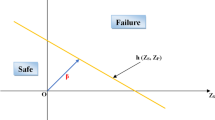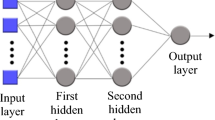Abstract
Because of the inherent uncertainty and unpredictability in pile design, a great deal of study has been done to measure the reliability of the structures. This paper offers machine learning (ML)–based prediction method for allowable load carrying capacity of pile foundation and examines and compares the applicability and adaptability of k-nearest neighbor (KNN), deep neural network (DNN), and random forest (RF) in the reliability investigation of pile embedded in cohesionless soil. These three ML models are applied to 150 datasets, considering five important inputs, namely, the diameter of the pile (d), the angle of the internal friction of the soil (φ), the unit weight of the soil (γ), the friction angle between the soil and the pile (δ), and the factor of safety (FOS) for predicting allowable load carrying capacity (Q). A range of performance metrics, including coefficient of determination (R2), variance account factor (VAF), Legate and McCabe’s index (LMI), A-10 index, Willmott’s index of agreement (WI), root mean square error (RMSE), median absolute deviation (MAD), mean absolute error (MAE), mean square error (MSE), and expanded uncertainty (U95), are employed to assess the efficacy of the well-established ML models. Using performance metrics, the results show that, of the three proposed ML models, DNN had the best predictive performance due to its highest value of R2 = 0.9678 and the lowest value of RMSE = 0.0306 in the training phase and R2 = 0.9853 and RMSE = 0.0145 in the testing phase. The model’s performance is also examined using rank analysis, reliability analysis, regression plot, REC curve, objective function criterion, Akaike information criterion, and error matrix plot. The model’s reliability index (β) is computed using first-order second moment (FOSM) techniques and compared with the actual value. Additionally, to know the effect of each input parameter on the output, a sensitivity analysis is conducted.














Similar content being viewed by others
Data Availability
Data presented in the paper are available with the authors.
References
Ahmad, F., Samui, P., Mishra, S.S.: Probabilistic analysis of slope using Bishop method of slices with the help of subset simulation subsequently aided with hybrid machine learning paradigm. Indian Geotech. J. (2023). https://doi.org/10.1007/s40098-023-00796-3
Akaike, H.: Information theory and an extension of the maximum likelihood principle. In: Parzen, E., Tanabe, K., Kitagawa, G. (eds.) Selected papers of Hirotugu Akaike Springer series in statistics (Perspectives in Statistics), pp 199–213. Springer, New York (1998)
Bardhan, A., Singh, R.K., Ghani, S., Konstantakatos, G., Asteris, P.G.: Modelling soil compaction parameters using an enhanced hybrid intelligence paradigm of ANFIS and improved grey wolf optimiser. Mathematics 11(14), 3064 (2023). https://doi.org/10.3390/math11143064
Breiman, L.: Random forests. Mach. Learn. 45(1), 5–32 (2004)
Casagrande, A.: Role of calculated risk in earthwork and foundation engineering. J. Soil Mech. Found. Div. 91, 1–40 (1965)
Cherubini, C., Giasi, C.I., Rethati, L.: The coefficients of variation of some geotechnical parameters. In: Proceedings of the conference on probabilistic methods in geotechnical engineering, pp 179–183. Canberra (1993)
Deepa, G., Niranjana, A., Balu, A.S.: A hybrid machine learning approach for early cost estimation of pile foundations. J. Eng. Des. Technol. (2023). https://doi.org/10.1108/JEDT-03-2023-0097
Galib, M.H., Billah, M., Mofiz, S.A.: Prediction of bearing capacity of pile using machine learning approach. International Conference on Planning, Architecture and Civil Engineering, Rajshahi University of Engineering & Technology, Rajshahi, Bangladesh (2023)
Gandomi, A.H., Alavi, A.H., Sahab, M.G., Arjmandi, P.: Formulation of elastic modulus of concrete using linear genetic programming. J. Mech. Sci. Technol. 24, 1273–1278 (2010)
Ghani, S., Kumari, S.: Liquefaction behavior of Indo-Gangetic region using novel metaheuristic optimization algorithms coupled with artificial neural network. Nat. Hazards 111, 2995–3029 (2022). https://doi.org/10.1007/s11069-021-05165-y
Ghani, S., Kumari, S.: Prediction of soil liquefaction for railway embankment resting on fine soil deposits using enhanced machine learning techniques. J. Earth Syst. Sci. 132, 145 (2023). https://doi.org/10.1007/s12040-023-02156-4
Ghani, S., Kumari, S., Choudhary, A.K., et al.: Experimental and computational response of strip footing resting on prestressed geotextile-reinforced industrial waste. Innov. Infrastruct. Solut. 6, 98 (2021). https://doi.org/10.1007/s41062-021-00468-2
Ghani, S., Kumari, S., Ahmad, S.: Prediction of the seismic effect on liquefaction behavior of fine-grained soils using artificial intelligence-based hybridized modeling. Arab. J. Sci. Eng. 47, 5411–5441 (2022). https://doi.org/10.1007/s13369-022-06697-6
Ghani, S., Kumari, S., Choudhary, A.K.: Geocell mattress reinforcement for bottom ash: a comprehensive study of load-settlement characteristics. Iran J. Sci. Technol. Trans. Civ. Eng. (2023). https://doi.org/10.1007/s40996-023-01205-8
Ghani, S., Chhetri, S., Raushan, S., Singh, K., Bardhan, A., Asteris, P.G.: Modelling and validation of liquefaction potential index of fine-grained soils using ensemble learning paradigms. Soil Dyn. Earthq. Eng. 177, 108399 (2024). https://doi.org/10.1016/j.soildyn.2023.108399
Harr, M.: Reliability-based design in civil engineering. Dover Publications, New York, NY, USA (1996)
Jiang, S., Xiao, R., Wang, L., Luo, X., Huang, C., Wang, J.H., Chin, K.S., Nie, X.: Combining deep neural networks and classical time series regression models for forecasting patient flows in Hong Kong. IEEE Access 7, 118965–118974 (2019)
Karakas, S., Ulker, M.B.C., Taskin, G.: Prediction of load capacities of closed-ended piles using boosting machine learning methods. In: book: 5th International Conference on New Developments in Soil Mechanics and Geotechnical Engineering (2023). https://doi.org/10.1007/978-3-031-20172-1_21
Khatti, J., Samadi, H., Grover, K.S.: Estimation of settlement of pile group in clay using soft computing techniques. Geotech. Geol. Eng. (2023). https://doi.org/10.1007/s10706-023-02643-x
Kodsa, A., Ozturk, B., Iskander, M.: Forecasting of pile plugging using machine learning. Acta Geotechnica 18(3) (2023). https://doi.org/10.1007/s11440-023-01797-5
Kumar, P., Samui, P.: Design of an energy pile based on CPT data using soft computing techniques. Infrastructures 7(12), 169 (2022). https://doi.org/10.3390/infrastructures7120169
Kumar, M., Bardhan, A., Samui, P., Hu, J.W., Kaloop, M.R.: Reliability analysis of pile foundation using soft computing techniques: a comparative study. Processes 9, 486 (2021). https://doi.org/10.3390/pr9030486
Kumar, M., Kumar, V., Rajagopal, B.G., Samui, P., Burman, A.: State of art soft computing based simulation models for bearing capacity of pile foundation: a comparative study of hybrid ANNs and conventional models. Model. Earth Syst. Environ. 9, 2533–2551 (2022a). https://doi.org/10.1007/s40808-022-01637-7
Kumar, M., Biswas, R., Kumar, D.R., Pradeep, T., Samui, P.: Metaheuristic models for the prediction of bearing capacity of pile foundation. Geomech. Eng. 29(2), 129–147 (2022b). https://doi.org/10.12989/gae.2022.31.2.129
Kumar, M., Samui, P.: Reliability Analysis of Pile Foundation Using GMDH, GP and MARS. In: book: CIGOS 2021, Emerging Technologies and Applications for Green Infrastructure (2022). https://doi.org/10.1007/978-981-16-7160-9_117
Kumar, A., Bag, R., Samui, P.: Design and reliability analysis of energy pile using soft computing technique and a comparative study between the developed soft computing models. Symp. Energy Geotech. (2023). https://doi.org/10.59490/seg.2023.536
Liu, S., Zhang, Z.: A multi-stage prediction KNN algorithm based on center vector. Comput. Eng. Sci. 39(9), 1758–1764 (2017)
Mishra, P., Samui, P., Mahmoudi, E.: Probabilistic design of retaining wall using machine learning methods. Appl. Sci. 11(12), 5411 (2021). https://doi.org/10.3390/app11125411
Murthy, V.: Soil Mechanics and Foundation Engineering. Distributors Pvt Ltd., Delhi, India, CBS Publisher, New Delhi, India (2010)
Mustafa, R., Samui, P., Kumari, S., et al.: Probabilistic analysis of gravity retaining wall against bearing failure. Asian J. Civ. Eng. 24, 3099–3119 (2023). https://doi.org/10.1007/s42107-023-00697-z
Nguyen, T.H., Nguyen, K.V.T., Ho, V.C., et al.: Efficient hybrid machine learning model for calculating load-bearing capacity of driven piles. Asian J Civ Eng. (2023). https://doi.org/10.1007/s42107-023-00818-8
Nogueira, C.G., Boni, H.S., Giacheti, H.L.: (2022) Probabilistic analysis of bored pile foundations in the design phase: an application example. Geotech. Geol. Eng. 40, 335–353 (2022). https://doi.org/10.1007/s10706-021-01893-x
Oh, D.W., Kong, S.M., Kim, S.B., Lee, Y.J.: Prediction and analysis of axial stress of piles for piled raft due to adjacent tunneling using explainable AI. Appl. Sci. 13(10), 6074 (2023). https://doi.org/10.3390/app13106074
Opeyemi, D.A.: Probabilistic failure analysis of static pile capacity for steel in cohesive and cohesionless soils. Electron. J. Geotech. Eng. 14, 1–12 (2009)
Peck, R.B.: Advantages and limitations of the observational method in applied soil mechanics. Geotechnique 19, 171–187 (1969)
Pham, B.T., Nguyen, D.D., Thi, Q.A.B., Nguyen, M.D., Vu, T.T., Prakash, I.: Estimation of load-bearing capacity of bored piles using machine learning models. Vietnam J. Earth Sci. (2022). https://doi.org/10.15625/2615-9783/17177
Phoon, K.K., Kulhawy, F.H.: Characterization of geotechnical variability. Can. Geotech. J. 36, 612–624 (1999)
Shrestha, N., Gupta, M., Ghani, S., et al.: Enhancing seismic vulnerability assessment: a neural network effort for efficient prediction of multi-storey reinforced concrete building displacement. Asian J. Civ. Eng. 25, 2843–2865 (2024). https://doi.org/10.1007/s42107-023-00949-y
Thapa, I., Ghani, S.: Estimation of California bearing ratio for hill highways using advanced hybrid artificial neural network algorithms. Multiscale Multidiscip. Model. Exp. Des. (2023). https://doi.org/10.1007/s41939-023-00269-3
Thapa, I., Ghani, S.: Applying optimized machine learning models for predicting unconfined compressive strength in fine-grained soil. Transp. Infrastruct. Geotech. (2024). https://doi.org/10.1007/s40515-024-00372-z
Weifang, Z.: Predicting the maximum dry density of soil by using the individual and hybrid framework of the decision tree. Indian Geotech J. (2023). https://doi.org/10.1007/s40098-023-00827-z
Zhang, J.: Quantification of compaction properties of lateritic soils: usage of hybridized ANFIS model. Indian Geotech J. (2023). https://doi.org/10.1007/s40098-023-00810-8
Zhang, J., Hu, J., Li, X., Li, J.: Bayesian network based machine learning for design of pile foundations. Autom. Constr. 118, 103295 (2020). https://doi.org/10.1016/j.autcon.2020.103295
Author information
Authors and Affiliations
Contributions
Rashid Mustafa: Conceptualization, data curation, formal analysis, investigation, methodology, software, validation, visualization, writing (original draft), writing—review and editing. Md Talib Ahmad: Software.
Corresponding author
Ethics declarations
Ethics Approval and Consent to Participate
Not applicable.
Consent for Publication
Not applicable.
Competing Interests
The authors declare no competing interests.
Additional information
Publisher's Note
Springer Nature remains neutral with regard to jurisdictional claims in published maps and institutional affiliations.
Rights and permissions
Springer Nature or its licensor (e.g. a society or other partner) holds exclusive rights to this article under a publishing agreement with the author(s) or other rightsholder(s); author self-archiving of the accepted manuscript version of this article is solely governed by the terms of such publishing agreement and applicable law.
About this article
Cite this article
Mustafa, R., Ahmad, M.T. Reliability Analysis of Pile Foundation in Cohesionless Soil Using Machine Learning Techniques. Transp. Infrastruct. Geotech. (2024). https://doi.org/10.1007/s40515-024-00391-w
Accepted:
Published:
DOI: https://doi.org/10.1007/s40515-024-00391-w




